 |  |
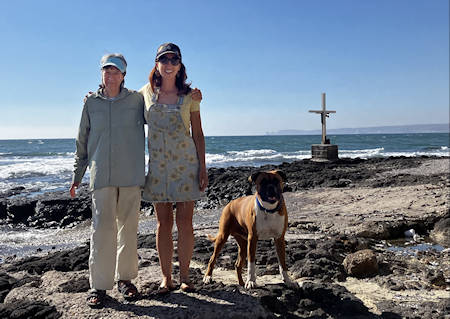
The thick fog is pulling back from the shoreline and it looks like a great, white mountain sitting on top of the sparkling blue Pacific. Soon it will disappear and the horizon will join sky and water. Georgia Tanner, Paula Pijoan and I get settled in on the patio of a quaint seaside restaurant and surveyed the menu. Brown pelicans skim by just above the breaking waves. There is a sense of excitement about the opportunity to share their stories. Between the two, they have over one hundred years of riding the waves. Georgia, a Baja resident, freelance writer, and advocate of living off-grid, is the elder at 87. She still surfs; wishing for warmer water in the northern state. Paula Pijoan is part of the Pijoan family winery. Today she has almost single handedly brought awareness to the need of protecting the native plants of Baja California. Paula is licensed in the Shinrin-Yoku as a Forest Bathing Guide. Both women have won Mexico’s San Miguel surfing competition.
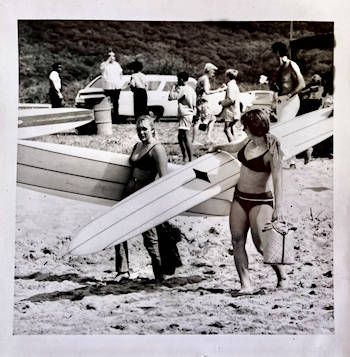
These days it is natural to see women surfers competing with the guys for a position and catching the biggest waves around the world. And in some cases they are making as much money as the men in competition. But it wasn’t too long ago that women didn’t surf, instead watching the super tanned guys on their 9-foot longboards from shore. Georgia remembers those days and lives by the words of Carl Jung, “Live as if you were to die tomorrow. Learn as if you were to live forever.” Her life proves she never faltered as she begins her story. “Surfing has kept me from aging and I still walk four miles a day. She had her first surfing lesson in 1946 when she was ten years old. It was a gift from her father to keep her busy during a vacation in Waikiki. (That's Georgia in the photo at the top of the page.) She found her lifelong passion - water and the waves. “My first off-road trip was in 1966 to K181, Erendira. I couldn’t believe the experience I had. I’d taken a head-high wave when two dolphins actually pulled out in front of me. The closest dolphin looked back at me as if to say, “You’re coming with us.” Much later I would join the dolphin communication project with Dr. John Lilly.” Georgia has literally surfed the entire Baja coastline. “Both states have good waves, depending on conditions. In 1976 at San Juanico, known to surfers as Scorpion Bay in Baja Sur, I stayed the whole summer. There was only an occasional surf rig that would pass through. Oh, what a life. We lived on seafood and traded lobster for peanut butter.” She admits that it hurts her to see the development with so many surfers now crowding the waves. There was no GPS or paved roads yet. “It was just the best in the 70s, bad roads, good people, actually hardly any people. Gas siphoned out of drums. There were frequent stops of our surf caravan to figure out which fork in the road to take.” They used a 1956 reference book by Gerhard and Gulick, Lower California Guide Book, which showed the dirt roads. Georgia knew that Baja was her home and she moved permanently in 1979.
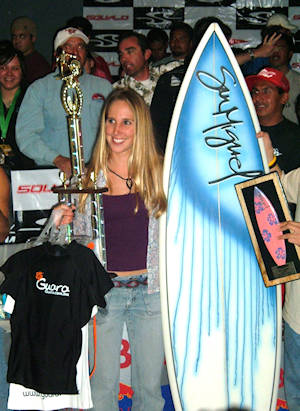
Paula, a Mexican national, has seen the history of women surfing in Mexico. She was 19 when she first entered the water in 2000. She remembers there were less than 5 women in Baja surfing at the time. Paula, always called to nature, was ready to give it a try. She explained, “I was kind of a tomboy and I hung out with the guys, they were like my brothers.” It didn’t take long before the young women of Ensenada saw her skill and approached her to teach them. Along with a friend, Paula created a surfing school for women, Mujer de Mar, in 2011. “For 3 years I was grateful for the opportunity to teach these women, more than just surfing, but also what they were capable of. You really have to be strong to surf, but it is a skill women can learn.” Finishing up her Master’s degree, she wrote her thesis on the importance of surfing to the city of Ensenada.
We all settled in for a great afternoon of storytelling. Georgia remembers, “In the 1950s and 60s surfers were dismissed by the masses and surfing was considered a male sport, so a few of us women created a small group in the water to deal with the dominance of men. This changed as time went on.” We all laughed when Paula chimed in, “It really changed when the women began to wear bikinis!” Georgia continued, “I suspect the U.S. work ethic had much to do with the early dismissive attitude. We surfers were having too much fun to join the caste system that has developed around money.”
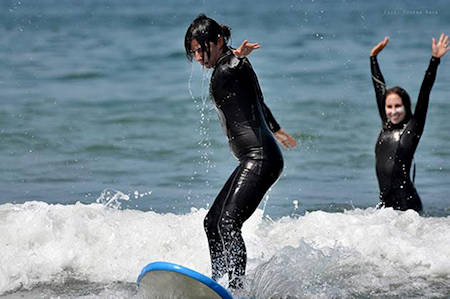
The waitress brought our drinks and Georgia said as she gazed out over the sparkling water, “I mentioned surfing in the early days being a man’s sport, but that wasn’t true in Hawaii. I remembered the 500-year-old story of Kelea that I found in a library in New Zealand. It was a book on legends of the Polynesians. In the story, Kelea, daughter of the high chief of Maui, was described as “wayward, volatile, and capricious,” and would not accept any of the high chiefs who wanted to marry her. She rode the waves so fearlessly that those who watched were inclined to believe that she was protected by some water-deity. Ancient people were painted on the walls of a 12th Century Polynesia cave. The Polynesians brought surfing to Hawaii. These early people thought of surfing as a spiritual practice. When they crafted a board their tree selection was very important. When shaping the board, it was done in ritual and asking for protections from the gods. The ancients knew the sea and its mystery. Both Georgia and Paula heard the siren’s call. They hold significant history of the earlier days in Baja, and keep the secrets of Baja California’s best point breaks. Each have had their mystical experience when the sea welcomed them into the sheer joy of riding the perfect waves. Kelea would have been proud of them.
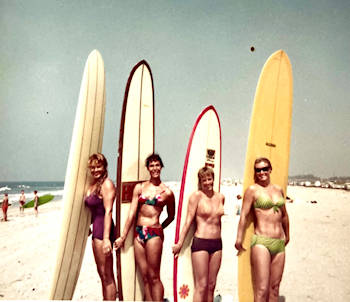
As they told their stories, they were surprised at how many of their experiences were similar, even though decades apart. They both said that at first the men really had an issue with them being in the water. Georgia reported, “In 1956 the guys were downright hostile. Our little group of women would run interference for one another to get in position for the wave. Paula felt the judgement, but eventually found comfort with her brothers.
All surfers encounter at some point, an accident. Georgia recalls that she had a wipeout on her long board. She described how it hit her so hard, “My nose was smashed across my face. I’d gone out angry and you just can’t do that. Now before I go out, I say a little prayer to honor the sea.” Paula also was humbled by the ocean, “Growing up I was a smart kid in school and learning came easily. But surfing took me a long time to learn. It was a humble pie experience. At San Miguel I had a wipeout, and was bashed against the rocks; head over heels, feet up in the air. I was humiliated.” As she left the water, she admits she gave an angry hand sign to the ocean. Georgia grimaced and said, “Oh, no.” Paula shrugs as if to say yes, “Next time I went out with my 6’2’ board it hit me in the face and broke my nose. I got the message; I’d insulted the sea. Both wise women now say that the ocean is a hard teacher. They say that you have to be in right relationship with the water and believe it has a consciousness.
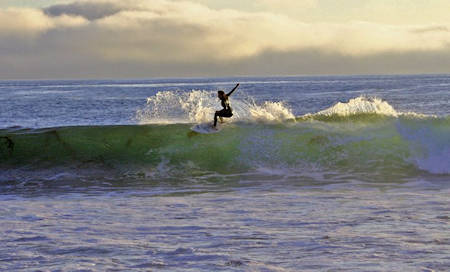
In 1969, before women were professional, Georgia surfed the San Miguel Amateur Competition. There were three amateur divisions. Taking wave after wave with ease, she aced each one, moving her into the top 5. For her that was good enough and she felt no need to compete again. She went back to what she calls “soul surfing.” Paula won first place in the Mexican national contest at San Miguel in 2005. “I was up against world class women surfers from all over Mexico. I felt I couldn’t win. So, I didn’t feel any pressure. I did it to have some fun. As it turns out, I could do no wrong.” Like Georgia, Paula was good with the experience and didn’t need more. She left surfing behind and turned toward the hills. She heard a call to journey through the world of Baja’s native plants, hearing their need to survive.
The great vastness of the sea gifted both women with experiences that are part of them now. Paula reveals, “The ocean taught me that there is a deep mysterious unknown.” Georgia, forever the “water woman” shared, “Surfing gave me freedom from the heaviness and restrictions of life on land. Just being on the water, in contact with nature and the immense extraterrestrial energy of the ocean, is an instant change of consciousness. Surfing is like flying along gravity-free, playing on the same wave face where pelicans glide.” There is no doubt that Kelea is proud of these two women of the sea.
Martina's email: mteomaya(at)gmail.com

It was great, thank you

Went down to TJ June 11 2020 No problems going into TJ but the way back was a ordeal 6 hours in...

Great service, very helpful people there.